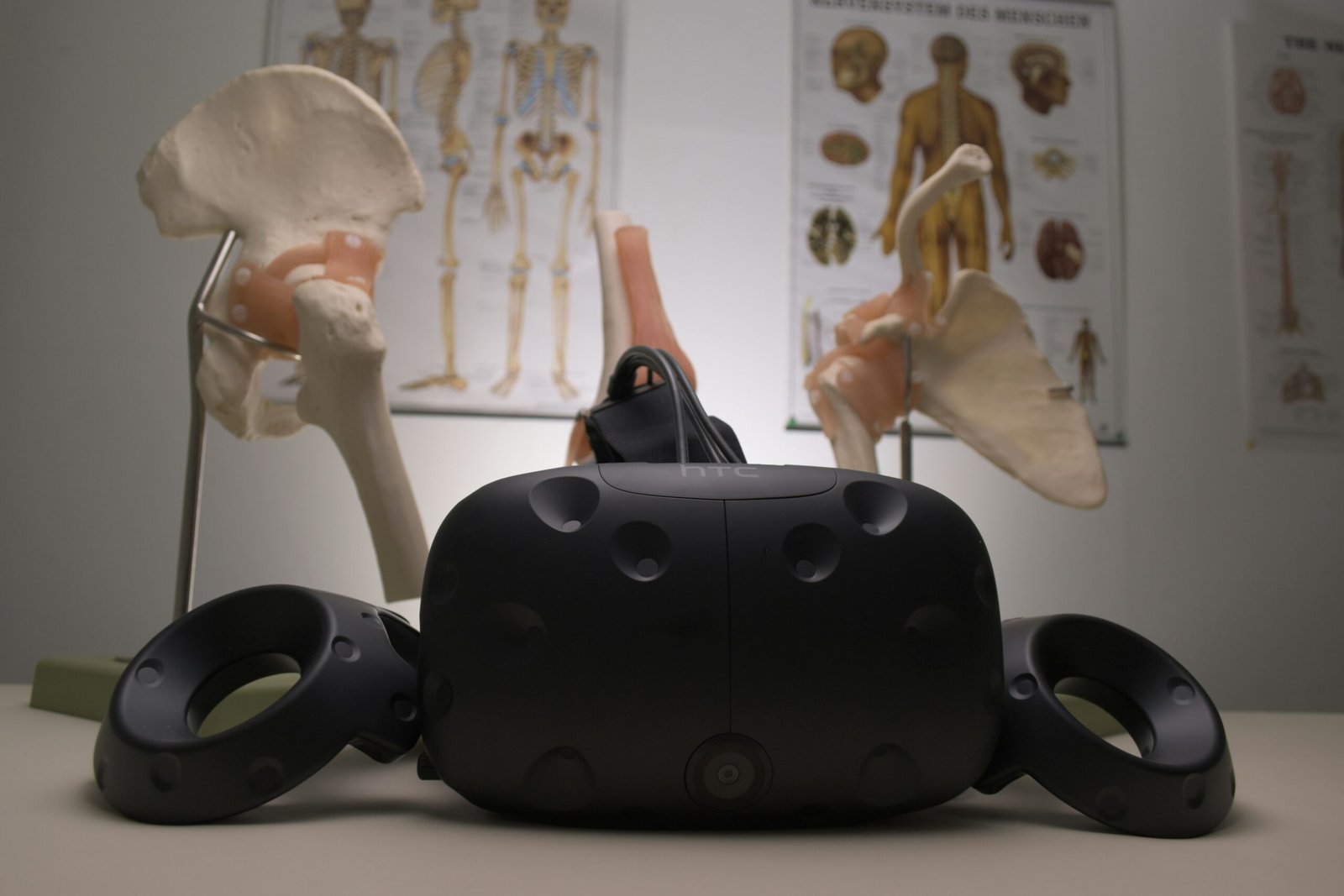Can VR Therapy Heal Mental Health? Exploring the Potential of Virtual Reality in Psychological Treatment
 Photo by Jesper Aggergaard on Unsplash
Photo by Jesper Aggergaard on Unsplash Introduction to VR Therapy
Virtual Reality (VR) therapy represents an innovative approach in the domain of psychological treatment, utilizing immersive technology to create simulated environments for therapeutic purposes. This modern clinical methodology aims to enhance traditional therapeutic practices by providing patients with a safe and controlled space where they can confront various mental health issues such as anxiety, phobias, and post-traumatic stress disorder (PTSD). By immersing individuals in realistic scenarios, VR therapy encourages engagement, allowing therapists to facilitate exposure therapy or cognitive behavioral therapy in ways that were previously unattainable.
The essence of VR therapy lies in its ability to transport patients into alternate realities crafted by advanced software, enabling them to experience situations that might be difficult to access in real life. This immersive nature not only aids in alleviating symptoms of anxiety and other disorders but also fosters a sense of agency, as patients can manipulate their environments and processes within these virtual worlds. As a result, they can practice coping mechanisms or social skills while surrounded by controlled elements that might trigger their conditions.
Moreover, VR therapy offers a significant advantage in terms of accessibility and comfort. Patients can engage with therapeutic environments tailored to their specific needs from the comfort of their homes or a clinic, which reduces the anxiety that often accompanies traditional therapy settings. The adaptability of virtual reality modules means that therapists can customize experiences based on individual progress and preferences, further enhancing treatment efficacy. Overall, the combination of immersive engagement and therapeutic guidance positions VR therapy as a promising avenue for improving the mental health landscape, ultimately providing hope and healing for individuals facing a range of psychological challenges.
The Rise of Digital Therapeutics
Over the past decade, the field of mental health treatment has witnessed a significant transformation through the rise of digital therapeutics, particularly in the realm of virtual reality (VR). This shift has been driven by the increasing prevalence of mental health disorders, coupled with a growing recognition of the need for innovative and effective treatment modalities. According to a report by the World Health Organization (WHO), one in four individuals will experience a mental health issue at some point in their lives, underscoring the urgency for accessible and scalable interventions.
Within this context, digital therapeutics have gained traction as an alternative to traditional therapy. Studies have indicated that the global digital therapeutics market is expected to reach USD 13 billion by 2026, growing at a compound annual growth rate (CAGR) of 25.2%. This remarkable expansion is attributed to the increasing acceptance of technology-based solutions among healthcare professionals and patients alike. VR therapy, in particular, has emerged as a promising avenue, offering immersive and interactive experiences that can enhance therapeutic engagement and efficacy.
Moreover, mental health professionals have begun to recognize the potential of VR as a complementary tool in treatment regimens. A survey conducted in early 2023 revealed that over 60% of mental health practitioners expressed interest in integrating VR therapy into their practices, highlighting a growing trend towards innovative approaches in psychological treatment. Both patients and providers are increasingly turning to technology-based solutions due to the flexibility, accessibility, and reduced stigma associated with digital platforms.
As digital therapeutics continue to evolve, there is immense potential for VR therapy to address various mental health challenges. By harnessing the capabilities of virtual environments to simulate real-world scenarios, VR can help individuals confront and manage their fears, anxiety, and other related conditions, thereby paving the way for a more integrated approach to mental wellness.
Effectiveness of VR Therapy for Anxiety Disorders
Virtual Reality (VR) therapy has emerged as a significant advancement in psychological treatment, particularly for individuals suffering from anxiety disorders such as Post-Traumatic Stress Disorder (PTSD), phobias, and generalized anxiety. Numerous research studies have delved into the effectiveness of this innovative approach, revealing promising results that suggest VR therapy can facilitate therapeutic processes in unique ways. One of the most compelling areas of study has been the use of VR in exposure therapy, a common treatment for various anxiety disorders.
Exposure therapy, which involves the gradual exposure to anxiety-inducing stimuli in a controlled environment, has been effectively enhanced through VR technology. For instance, studies have shown that individuals with phobias, such as fear of heights or spiders, exhibit reduced anxiety levels after engaging in VR scenarios that simulate these fears. In a controlled study, participants exposed to a virtual environment that replicated their phobia reported significant decreases in their anxiety symptoms over time, illustrating the potential of VR to support traditional therapeutic techniques.
Additionally, research focusing on PTSD has demonstrated that VR therapy can produce remarkable outcomes. A meta-analysis highlighted how veterans and trauma survivors experienced reductions in PTSD symptoms when immersed in VR simulations that recreated events associated with their trauma. The immersive nature of VR allows for a safe space where individuals can confront their fears without the risks associated with real-life exposure.
Patient experiences further bolster the evidence supporting VR therapy. Many individuals report feelings of increased control and reduced fear when participating in VR scenarios. These positive outcomes indicate that VR therapy can serve as an adjunct to existing therapeutic modalities, fostering a more comprehensive approach to treating anxiety disorders. It is important, however, that VR therapy is administered by trained professionals to ensure efficacy and safety, reflecting best practices in mental health treatment.
VR Therapy for Depression and Other Mental Health Conditions
Virtual Reality (VR) therapy is emerging as a promising tool for addressing a variety of mental health conditions, including depression. This innovative approach utilizes immersive environments to create engaging therapeutic experiences, providing an alternative or complement to traditional psychotherapy. Current research demonstrates that VR can be effective in reducing symptoms of depression by facilitating exposure therapy, enhancing mindfulness practices, and improving emotional regulation.
One notable aspect of VR therapy is its ability to simulate real-life scenarios without the associated risks of exposure in the physical world. For instance, individuals suffering from depression may struggle with social interactions. VR can recreate social settings where patients can practice social skills or confront social anxiety in a controlled manner. This safe space allows for the gradual desensitization to stressful situations, promoting confidence and competence in real-life interactions.
Moreover, studies have indicated that VR therapy can enhance standard cognitive-behavioral therapy (CBT) approaches. By integrating VR experiences with traditional therapeutic conversations, therapists can provide immediate feedback and monitor patients’ responses in real-time, fostering deeper introspection. The immersive nature of VR helps individuals visualize their challenges, making it easier to process emotions and thoughts associated with depression.
Notably, the adaptability of VR therapy makes it suitable for various age groups and backgrounds. As technology becomes more widespread, therapists can offer tailored VR interventions that cater to the individual’s specific needs, thereby improving treatment outcomes. Additionally, ongoing research continues to expand the applications of VR in mental health care, exploring its use in areas such as trauma recovery, anxiety disorders, and phobias.
As VR therapy gains traction within therapeutic frameworks, it holds potential for revolutionizing how mental health conditions, particularly depression, are treated. The synergy between VR technology and traditional therapeutic practices may pave the way for more effective, personalized treatment plans.
User Experience and Engagement in VR Therapy
User experience plays a pivotal role in the effectiveness of virtual reality (VR) therapy. As therapeutic interventions evolve, the integration of gamification and immersive elements has transformed traditional mental health treatments. These innovations are designed to heighten patient engagement, which is crucial for positive outcomes in therapy.
Gamification refers to the incorporation of game-like features in non-game contexts, such as point scoring, competitions, and rewards. In the realm of VR therapy, these elements can serve to motivate patients, making the therapeutic process more enjoyable and less daunting. This enhanced motivation encourages users to participate actively in the treatment, thereby increasing the likelihood of achieving desired therapeutic goals. For instance, patients undergoing exposure therapy for phobias may find themselves more willing to confront their fears when presented in a game-like environment where success is rewarded.
The immersive nature of VR technology further amplifies user engagement. Unlike traditional therapeutic settings, VR environments can transport users to dynamic, controlled scenarios tailored to their specific needs. This level of immersion can allow patients to confront their issues in a safe setting, promoting a sense of agency over their experiences. Additionally, creating a compelling narrative within the VR experience can captivate patients’ attention, drawing them further into the therapeutic journey.
Moreover, the feedback provided by VR systems can also enhance user experience. Real-time adjustments based on patient responses can lead to more personalized therapy sessions, facilitating a deeper connection between the patient and the therapeutic process. As such, the efficacy of VR therapy hinges not only on the technology itself but also on how well it engages users and fosters an enriching experience. Ultimately, improving user experience in VR therapy is paramount for driving engagement, which is essential for successful mental health treatment outcomes.
Challenges and Limitations of VR Therapy
The use of virtual reality (VR) in therapeutic contexts presents a multitude of challenges and limitations that must be acknowledged to understand its viability as a treatment option for mental health concerns. One primary challenge lies in accessibility. While VR technology has advanced significantly, it is not universally available or affordable. High-quality VR systems often require significant financial investment, which may not be feasible for all healthcare facilities or individual therapists. This financial barrier can limit the scope of VR therapy, especially in underserved communities where mental health resources are already scarce.
Furthermore, the potential for adverse reactions in specific patients must be taken into account. Some individuals may experience discomfort or nausea while using VR, a phenomenon known as motion sickness. This side effect can obstruct the therapeutic process, as certain patients may find it difficult to remain engaged in the treatment when faced with such physical discomfort. Mental health practitioners need to carefully evaluate whether a patient is suitable for VR therapy, assessing both their psychological and physiological responses to the technology.
Additionally, the field of VR therapy is still in its infancy, which poses another significant limitation. There is a pressing need for comprehensive regulatory frameworks to ensure proper implementation and oversight. Currently, the lack of standardized guidelines can lead to inconsistencies in treatment delivery and effectiveness. Establishing robust regulatory measures will not only enhance the credibility of VR therapy but also protect patients from potentially harmful practices. Overall, while VR offers promising opportunities in mental health treatment, its integration into clinical practice necessitates careful consideration of these challenges and limitations.
Future Trends in VR Therapy
The field of virtual reality (VR) therapy is evolving rapidly, with numerous emerging technologies poised to reshape its landscape. One of the most significant areas of advancement lies in the integration of artificial intelligence (AI). AI can analyze user data in real-time, allowing for personalized therapy experiences tailored to individual needs. For instance, machine learning algorithms could adapt therapeutic scenarios based on a user’s responses within the VR environment, optimizing the therapeutic process and potentially improving outcomes.
Augmented reality (AR) also holds considerable promise in complementing VR therapy. By merging digital elements with the real world, AR can create a more immersive experience that encourages engagement and interaction. This can be particularly beneficial in exposure therapy for phobias, where clients progressively confront their fears in a controlled and safe environment. The blending of AR and VR technologies could lead to innovative training modules for both therapists and clients, fostering a deeper understanding of treatment methods.
Moreover, advancements in hardware, such as lightweight headsets and haptic feedback devices, will enhance the user experience. These improvements may facilitate longer therapy sessions with less discomfort, allowing clients to immerse themselves more fully in therapeutic activities. Additionally, the development of social VR platforms could enable group therapy sessions, where participants engage and share experiences in a virtual space, providing vital support and fostering a sense of community.
As technology continues to progress, ethical considerations surrounding its use will also become crucial. Addressing privacy concerns and ensuring the security of patient data must be a priority as VR therapy becomes more mainstream. Ultimately, the future trends in VR therapy indicate a promising horizon, where a blend of AI, AR, and improved hardware will enhance therapeutic experiences and potentially yield significant benefits for mental health treatment.
Patient Testimonials and Case Studies
The integration of virtual reality (VR) therapy into mental health treatment has garnered significant attention, resulting in compelling testimonials from individuals who have experienced its effects firsthand. Many patients suffering from anxiety disorders, phobias, and PTSD have shared transformative stories illustrating how VR therapy has positively affected their recovery journeys. For instance, one such case involved a 30-year-old woman grappling with a severe fear of flying. Traditional therapy methods had failed to alleviate her anxiety. However, after engaging in a VR exposure therapy program, she gradually confronted her fear through simulated flying scenarios. She reported a substantial decrease in anxiety levels, allowing her to take an actual flight for the first time in over a decade.
Moreover, individuals suffering from PTSD have also reported promising results. A veteran who experienced debilitating flashbacks after returning from active duty underwent VR therapy designed to help confront traumatic memories in a controlled environment. By reliving certain scenarios through VR, he found a way to process his experiences, which contributed to a significant reduction in his symptoms. His journey exemplifies how VR provides a safe space that fosters emotional confrontation, enabling patients to develop coping mechanisms.
Additionally, case studies involving children with autism spectrum disorders illustrate the potential of VR in therapeutic settings. One study showcased a young boy who struggled with social interactions. Through VR scenarios designed to simulate social situations, he was able to practice behavioral skills without the pressures of real-world interactions. Parents noted that VR therapy not only helped enhance their child’s social skills but also boosted his confidence levels.
The continuous collection of patient testimonials showcases the profound impact that VR therapy can have on mental health recovery. Through immersive experiences, individuals are finding new pathways to engage with their treatments, reinforcing the growing body of evidence supporting the efficacy of virtual reality as an innovative therapeutic tool.
Conclusion: The Path Forward for VR in Mental Health
Throughout this exploration of virtual reality (VR) therapy, we have examined its promising role in addressing various mental health challenges. As the integration of technology into psychological treatment continues to evolve, VR has emerged as a groundbreaking tool with the potential to revolutionize therapeutic practices. By providing immersive experiences that can replicate real-world scenarios, VR therapy offers unique avenues for individuals to confront fears, develop coping strategies, and engage in mindfulness techniques.
Moreover, the flexibility of VR therapy allows for personalized treatment plans tailored to the specific needs of patients. This customization not only enhances engagement but also facilitates deeper emotional processing, making it a valuable asset for clinicians. Research has indicated that VR therapy can be particularly beneficial for conditions such as anxiety, phobias, and post-traumatic stress disorder (PTSD), suggesting that it holds significant promise as a viable alternative or complement to traditional therapeutic approaches.
However, while the potential of VR in mental health is clear, further research is essential to fully understand its effectiveness across different demographics and conditions. Ongoing studies will be crucial in establishing standardized protocols, ensuring accessibility, and addressing ethical considerations surrounding its use. Additionally, the mental health community must advocate for the integration of VR into existing treatment frameworks, allowing clinicians to harness its capabilities to enhance patient care.
In conclusion, VR therapy represents an exciting frontier in mental health treatment. By fostering collaboration between researchers, clinicians, and technology developers, we can pave the way for innovative therapies that improve outcomes for individuals navigating mental health issues. As we continue to invest in this groundbreaking approach, the future of VR in psychological treatment looks promising, with the potential to create lasting change in the lives of many.



Tidak ada komentar